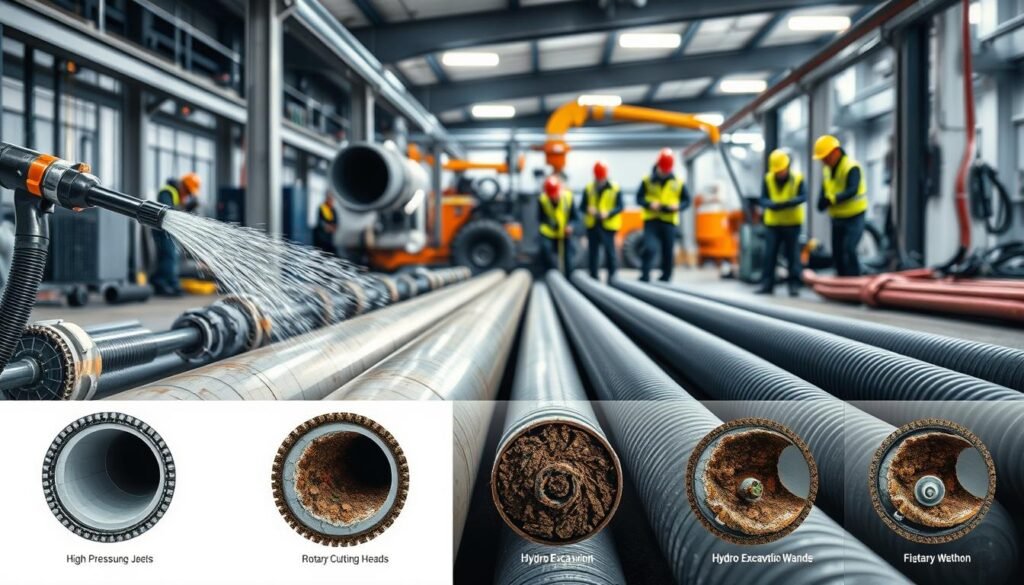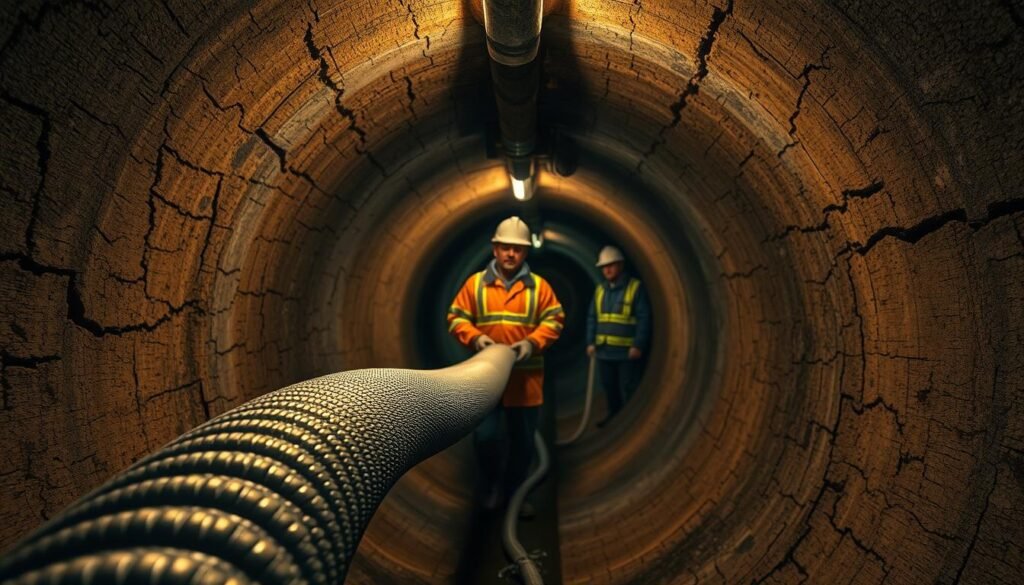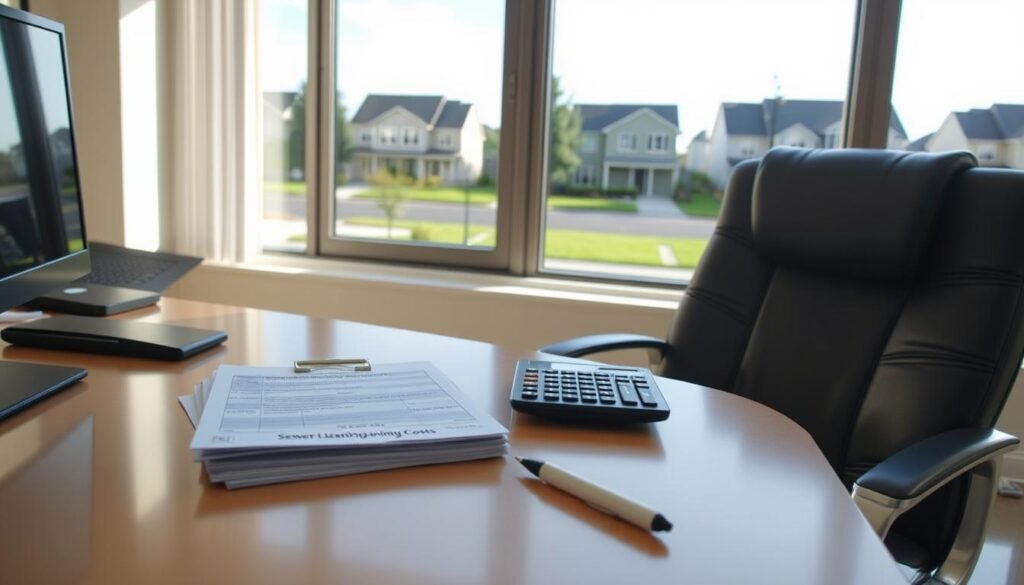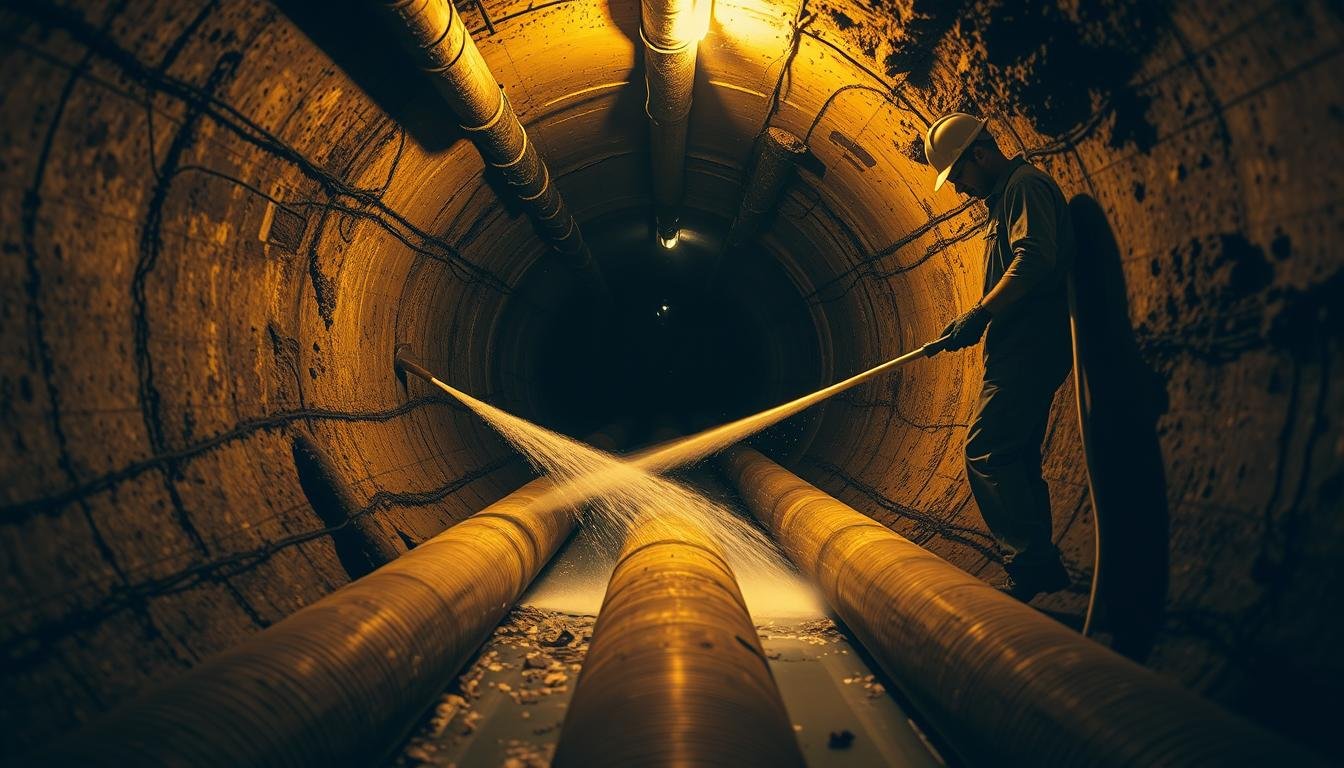Clogged sewer lines can disrupt daily life and come with a hefty price tag. The average cost to clean a sewer line can range from $75 to $400 or more. This cost varies based on the job’s complexity.
It’s essential for homeowners to grasp the factors affecting sewer line cleaning costs. This knowledge helps in budgeting and avoiding surprise expenses. The cost can change based on the blockage’s severity, the cleaning method, and the service provider.
Key Takeaways
- Average sewer line cleaning costs range from $75 to $400 or more.
- The complexity of the job significantly influences the final cost.
- Understanding the factors that affect costs can help homeowners budget.
- Different methods of cleaning can impact the overall expense.
- Professional service providers play a critical role in determining costs.
Understanding Sewer Line Systems
Knowing how sewer line systems work can save homeowners from expensive fixes. These systems carry wastewater from homes to treatment facilities or septic systems. They consist of pipes linking various drains in the home to the main sewer line. This line then connects to the municipal sewer or a septic tank.
Common Components of Residential Sewer Systems
The key parts include clay, PVC, or cast iron pipes of different diameters, designed for various pressures. Cleanouts and vents are also essential. They help with maintenance and ensure the system works right.
Signs Your Sewer Line Needs Cleaning
Signs it’s time for a sewer line cleaning include slow drains, gurgling sounds from drains, and sewage backups. These signs point to blockages or buildup in the sewer lines.
Importance of Regular Maintenance
Regular upkeep is vital to avoid big blockages and extend sewer line life. Scheduling regular cleanings can prevent emergencies and cut down the cost of cleaning. Understanding maintenance’s role helps homeowners make better choices about cleaning services, potentially saving money.
How Much Does It Cost to Clean Sewer Line: National Averages
National averages give a general idea of sewer line cleaning costs. It’s vital for budgeting and maintenance planning.
Typical Price Range for Residential Properties
Residential properties typically spend between $100 and $300 on sewer line cleaning. Costs vary with job complexity and cleaning method.
- Simple Cleaning: $100-$200
- Complex Cleaning: $200-$300
Commercial Property Cleaning Costs
Commercial properties face higher costs due to complex sewer systems. Cleaning costs range from $500 to over $1,000, influenced by system size and complexity.
Regional Price Variations Across the US
Regional differences in the US affect sewer line cleaning costs. Urban areas see higher costs due to demand and operational expenses. Rural areas might have lower costs but could face travel or accessibility charges.
In cities like New York or Los Angeles, costs are on the higher end. This is due to complex urban sewer systems and higher labor costs.
Factors That Influence Sewer Line Cleaning Costs
For homeowners, understanding what affects sewer line cleaning costs is key to accurate budgeting. Several elements play a role in determining the final price. It’s important to know what these factors are.
Length and Diameter of Sewer Lines
The size of sewer lines significantly impacts cleaning costs. Longer lines need more time and effort, raising the cost. Larger pipes might require specialized tools, further increasing the price.
Severity of Blockage or Buildup
The extent of the blockage or buildup is a major factor. Severe cases often need more advanced methods, like hydro jetting. This can be pricier than simpler methods like snaking.
Accessibility Issues
Accessibility to sewer lines can also affect costs. Lines that are hard to reach may need extra equipment or labor. This can drive up the total cost.
Property Location and Local Market Rates
Lastly, the location of the property and local market rates matter. Urban areas often have higher rates due to demand and operational costs. Rural areas might have lower rates but could face higher travel fees.
Understanding these factors helps homeowners estimate sewer line cleaning costs. This knowledge aids in making informed decisions about plumbing needs.
Different Sewer Line Cleaning Methods and Their Costs
Homeowners face a variety of sewer line cleaning methods, each with its own cost and benefits. It’s essential to grasp these options to make informed decisions about your plumbing system.
Hydro Jetting: Process and Pricing
Hydro jetting employs high-pressure water to clear blockages and clean sewer lines. This method effectively removes stubborn buildup and debris, ensuring proper flow.
The cost of hydro jetting varies from $300 to $1,000. This depends on the job’s complexity and the property’s location.

Snaking/Augering: When It’s Used and Cost
Snaking or augering uses a flexible rod to break up or retrieve blockages. It’s often less expensive than hydro jetting, costing between $100 and $500.
Yet, snaking may not tackle severe or recurring blockages effectively. It serves as a temporary solution.
Camera Inspection: Additional Costs and Benefits
A camera inspection involves inserting a camera into the sewer line for visual inspection. It helps identify blockage causes and assess sewer system health.
Camera inspection costs range from $100 to $300. It’s commonly used alongside other cleaning methods.
Chemical Treatments: Effectiveness and Price Points
Chemical treatments use specialized chemicals to dissolve blockages and debris. Though effective, it’s not suitable for all pipes and raises environmental concerns.
Chemical treatment costs vary, typically from $100 to $300.
| Method | Typical Cost | Effectiveness |
|---|---|---|
| Hydro Jetting | $300 – $1,000 | High |
| Snaking/Augering | $100 – $500 | Moderate |
| Camera Inspection | $100 – $300 | Diagnostic |
| Chemical Treatments | $100 – $300 | Varies |
Understanding the various sewer line cleaning methods and their costs empowers homeowners. They can make informed decisions about their professional sewer line cleaning cost. This ensures they choose the most effective solution for their needs.
When to Clean Your Sewer Lines: Frequency Guidelines
The frequency of sewer line cleaning varies based on several factors, including your property’s age. Understanding these factors is essential for maintaining a healthy plumbing system and avoiding expensive repairs.
Recommended Cleaning Schedule for Residential Properties
For homes, cleaning sewer lines every 1 to 2 years is generally advised as part of preventive maintenance. This regular cleaning helps prevent blockages and buildup, which can lead to more severe problems.
Benefits of Regular Cleaning:
- Reduces the risk of backups and overflows
- Helps maintain proper water flow
- Can extend the lifespan of your sewer lines
Warning Signs That Indicate Immediate Cleaning Needed
While regular maintenance is vital, certain signs suggest your sewer lines need immediate attention. These include:
- Frequent clogs or backups
- Slow drains
- Unusual noises from your plumbing system
- Foul odors around your property
If you notice any of these signs, it’s critical to have your sewer lines inspected and cleaned promptly. This action helps prevent further damage.
Special Considerations for Older Homes
Older homes often need more frequent sewer line cleaning due to the higher risk of buildup and deterioration in older pipes. If your home is several decades old, consider annual inspections of your sewer lines.
Additional factors to consider for older homes include:
- The material of your sewer pipes (e.g., clay, cast iron)
- Previous history of sewer line issues
- Any recent changes in your plumbing system’s performance
By understanding these factors and sticking to a regular cleaning schedule, you can ensure your sewer lines remain in good condition.
| Property Type | Recommended Cleaning Frequency | Factors to Consider |
|---|---|---|
| Residential | Every 1-2 years | Age of property, usage patterns |
| Commercial | Every 6-12 months | Higher usage, more debris |
| Older Homes | Annually | Pipe material, history of issues |
Emergency vs. Scheduled Cleaning: Price Differences
The cost of sewer line cleaning can vary significantly, depending on whether it’s an emergency or a scheduled service. Emergency cleanings, which are needed outside regular business hours, often come with higher prices. This is because the service is urgent.
After-Hours and Weekend Service Rates
Emergency sewer line cleaning calls during after-hours or weekends can increase costs by 50% to 100%. This is because plumbers charge a premium for the convenience and immediacy of their service.

Benefits of Preventative Maintenance Plans
Choosing scheduled or preventative maintenance plans can greatly reduce sewer line cleaning costs. These plans include regular inspections and cleanings. They help identify and address issues before they become emergencies.
How to Avoid Emergency Situations
To avoid emergency situations, homeowners should consider regular maintenance. This includes being mindful of what goes down the drains and scheduling annual or bi-annual inspections.
| Service Type | Typical Cost Range | Additional Fees |
|---|---|---|
| Scheduled Cleaning | $100-$500 | None |
| Emergency Cleaning | $200-$1,000 | After-hours: $100-$300 |
Understanding the differences between emergency and scheduled sewer line cleaning costs helps homeowners make informed decisions. This can save money and avoid the stress of emergency situations.
DIY Sewer Line Cleaning: Cost Analysis
For minor sewer line issues, DIY cleaning might be a feasible and affordable option. Homeowners can save on costs by attempting to clean their sewer lines themselves. It’s vital to understand the limitations and risks involved.
Tools and Equipment Needed
To start DIY sewer line cleaning, you’ll need specific tools and equipment. The most common tools include a drain snake (also known as an auger), a hydro jetter for more severe blockages, and a sewer camera for inspecting the line.
Rental vs. Purchase Costs
Renting equipment can be a cost-effective way to tackle DIY sewer line cleaning. For instance, renting a drain snake can cost between $20 to $50 per day. Purchasing one can range from $50 to $200. Hydro jetting equipment, on the other hand, is more expensive to rent or buy, with costs ranging from $1,000 to $3,000 or more.
| Equipment | Rental Cost (per day) | Purchase Cost |
|---|---|---|
| Drain Snake | $20 – $50 | $50 – $200 |
| Hydro Jetting Equipment | $200 – $500 | $1,000 – $3,000+ |
Step-by-Step Process for Basic DIY Cleaning
Begin by inspecting your sewer line with a sewer camera to identify the blockage. Then, use a drain snake to clear minor clogs. For tougher blockages, consider using a hydro jetter.
When DIY Is Appropriate vs. When to Call Professionals
DIY sewer line cleaning is suitable for minor issues. For complex problems or if you’re unsure, it’s best to call a professional. Professionals have the expertise and equipment to handle severe blockages and prevent future issues.
How to Save Money on Professional Sewer Line Cleaning
Several methods can help reduce costs on professional sewer line cleaning without sacrificing quality. Homeowners can adopt strategic approaches to cut down expenses significantly.
Timing Your Service for Off-Peak Seasons
Booking sewer line cleaning during off-peak seasons can save money. Plumbing services often offer discounts during their slow periods to draw in customers.
Bundling Services for Discounts
Combining multiple services with one provider can lead to savings. For example, pairing sewer line cleaning with drain inspections or other plumbing tasks can lower overall costs.
Maintenance Contracts and Their Value
Signing a maintenance contract with a plumbing service can lead to long-term savings. Regular upkeep prevents severe blockages and reduces the need for emergency calls.
Negotiating with Service Providers
It’s wise to negotiate with service providers. Some may offer discounts or flexible pricing, often for loyal customers or during slow seasons.
| Cost-Saving Strategy | Potential Savings |
|---|---|
| Off-Peak Scheduling | Up to 10% |
| Bundling Services | Up to 15% |
| Maintenance Contracts | Up to 20% |
Implementing these strategies can make professional sewer line cleaning more budget-friendly. Always compare quotes and services from various providers to secure the best deal.
How to Get Accurate Quotes for Sewer Line Cleaning
To ensure you’re getting a fair deal, it’s essential to understand how to get accurate quotes for sewer line cleaning. Several factors come into play to provide a precise estimate when seeking professional services.
Questions to Ask Service Providers
Before hiring a service provider, it’s vital to ask the right questions. Inquire about their experience with sewer line cleaning, the methods they use, and the equipment required. Also, ask about their pricing structure and what’s included in the quote. This helps you understand the total cost.
Red Flags to Watch For
Be cautious of service providers who give vague estimates or are unwilling to provide a detailed breakdown of costs. Extremely low quotes might be indicative of hidden fees or subpar service.
Comparing Apples to Apples: Understanding Quote Variations
When comparing quotes, ensure you’re comparing similar services. Some providers might include additional services like camera inspections or hydro jetting, which can affect the overall cost.
Online Resources for Price Comparisons
Utilize online resources to research average professional sewer line cleaning costs in your area. Websites like HomeAdvisor or Angi can provide valuable insights into pricing trends.
Insurance and Financing Options for Sewer Line Cleaning
Sewer line cleaning can be a significant expense, but there are insurance and financing options available to help homeowners manage these costs.

When Homeowners Insurance Might Cover Costs
In some cases, homeowners insurance may cover the cost of sewer line cleaning, if the blockage or damage is sudden and accidental. It’s vital to review your policy to understand what is covered.
Sewer Line Insurance and Warranty Programs
Specialized sewer line insurance and warranty programs can provide additional protection against costly repairs. These programs often cover maintenance and emergency services related to sewer line issues.
Payment Plans and Financing Options
Many plumbing service providers offer payment plans or financing options to help spread the cost of sewer line cleaning over time. This can make it more manageable for homeowners to address necessary maintenance or repairs.
Documentation Needed for Claims
When filing a claim for sewer line cleaning costs, homeowners typically need to provide documentation of the issue. This includes photos, videos, or inspection reports from a plumber. Keeping detailed records can help streamline the claims process.
| Insurance Type | Coverage | Typical Cost |
|---|---|---|
| Homeowners Insurance | Sometimes covers sudden damage | Varies by policy |
| Sewer Line Warranty | Covers maintenance and repairs | $50-$100 per year |
| Financing Options | Spreads cost over time | Interest rates apply |
Conclusion
Homeowners need to understand the various elements that impact sewer line cleaning costs. The cost can change a lot based on the sewer line’s length, diameter, blockage severity, and local rates. Regular maintenance is essential to avoid expensive emergency services. Knowing these factors and planning cleaning services can help manage budgets better.
It’s wise to compare quotes from different providers and consider maintenance contracts for long-term savings. Being informed about how much it costs to clean sewer lines enables homeowners to make better decisions for their plumbing systems.
Sources
For more information on sewer line cleaning costs and related topics, the following resources were consulted:
The United States Environmental Protection Agency (EPA) provides guidelines on maintaining and inspecting sewer lines.
The National Association of Sewer Service Companies (NASSCO) offers insights into various sewer line cleaning methods and their applications.
HomeAdvisor and other home service platforms provide cost estimates and contractor reviews for sewer line cleaning services.
These sources, along with industry reports and plumbing expert opinions, helped inform the discussion on sewer line cleaning costs and best practices.
For further reading and to explore the referenced materials, visit the respective websites of these organizations.
FAQ
What is the average cost of sewer line cleaning?
The cost of sewer line cleaning varies. It depends on location, blockage severity, and cleaning method. For homes, it usually falls between 0 and
FAQ
What is the average cost of sewer line cleaning?
The cost of sewer line cleaning varies. It depends on location, blockage severity, and cleaning method. For homes, it usually falls between $200 and $1,000 or more.
How often should I clean my sewer lines?
Residential properties should clean sewer lines every 1-2 years. This frequency can change based on usage, pipe age, and other factors.
What are the signs that my sewer line needs cleaning?
Signs your sewer line needs cleaning include slow drains and gurgling sounds. Also, sewage backups and unusual odors from drains or toilets are indicators.
Can I clean my sewer lines myself?
Yes, you can try DIY methods like snaking or hydro jetting. But for complex or severe blockages, it’s best to hire professionals.
How do I choose the right sewer line cleaning method?
The right method depends on the blockage, pipe material, and other factors. Consulting a professional can help choose the most effective method.
Are there any cost-saving strategies for sewer line cleaning?
Yes, save costs by cleaning during off-peak seasons. Bundling services and maintenance contracts can also help prevent emergencies.
Will my homeowners insurance cover sewer line cleaning costs?
Homeowners insurance might cover costs under certain conditions. Check your policy to see if it includes sewer line cleaning for covered events.
How can I get an accurate quote for sewer line cleaning?
To get an accurate quote, provide detailed information about your issue. Ask about the provider’s experience and methods. Compare quotes from different providers.
What factors influence the cost of sewer line cleaning?
Cost factors include sewer line length, diameter, blockage severity, and accessibility. Local market rates also play a role.
Are there financing options available for sewer line cleaning?
Yes, some providers offer financing or payment plans. Specialized insurance programs might also be available for sewer line cleaning.
,000 or more.
How often should I clean my sewer lines?
Residential properties should clean sewer lines every 1-2 years. This frequency can change based on usage, pipe age, and other factors.
What are the signs that my sewer line needs cleaning?
Signs your sewer line needs cleaning include slow drains and gurgling sounds. Also, sewage backups and unusual odors from drains or toilets are indicators.
Can I clean my sewer lines myself?
Yes, you can try DIY methods like snaking or hydro jetting. But for complex or severe blockages, it’s best to hire professionals.
How do I choose the right sewer line cleaning method?
The right method depends on the blockage, pipe material, and other factors. Consulting a professional can help choose the most effective method.
Are there any cost-saving strategies for sewer line cleaning?
Yes, save costs by cleaning during off-peak seasons. Bundling services and maintenance contracts can also help prevent emergencies.
Will my homeowners insurance cover sewer line cleaning costs?
Homeowners insurance might cover costs under certain conditions. Check your policy to see if it includes sewer line cleaning for covered events.
How can I get an accurate quote for sewer line cleaning?
To get an accurate quote, provide detailed information about your issue. Ask about the provider’s experience and methods. Compare quotes from different providers.
What factors influence the cost of sewer line cleaning?
Cost factors include sewer line length, diameter, blockage severity, and accessibility. Local market rates also play a role.
Are there financing options available for sewer line cleaning?
Yes, some providers offer financing or payment plans. Specialized insurance programs might also be available for sewer line cleaning.
